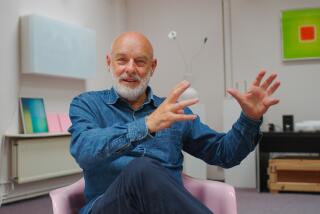Science films of ‘50s not just a memory anymore
Three identical little men with levers regulate the flow of blood to various parts of the human body. Birds fly through the calm eye of a hurricane.
Puppets of Edgar Allan Poe, Feodor Dostoyevsky and Charles Dickens debate the merits of a scientific whodunit. The sun scoffs at the efforts of scientists to understand his secrets.
These images -- and numerous others -- from “Frank Capra’s Wonders of Life,” generally known as “The Bell Science Series,” are indelibly etched into the memories of baby boomers. During the ‘50s and ‘60s, “Our Mr. Sun” (1956), “Hemo the Magnificent” (1957), “Strange Case of the Cosmic Rays” (1957) and “Unchained Goddess” (1958) were commonplace in science classes.
Shown via clattering 16-millimeter projectors to classrooms full of students grateful for a break from regular lessons, such films may seem quaint now, if not downright alien. The VHS and then DVD revolutions made the concept of seeing films of any kind in any setting seem commonplace, except perhaps in schools, where budget cuts make even the so-called educational films a precious luxury. Until now, these kinds of films have been slow to make the transition to home entertainment.
But these four imaginative, entertaining films, created in response to a Cold War threat, have just been released on DVD for the first time.
The destruction of Hiroshima and the nuclear arms race had produced a negative image of science in America, but the launch of the Soviet Union’s Sputnik satellite inaugurated the Space Race -- and created an increased demand for scientists.
Working through their advertising agency, N.W. Ayers, the directors of the Bell Telephone System (precursor to AT&T;) underwrote a series of hourlong programs designed to promote an interest in science among young people, improve the image of scientists and increase the scientific literacy of the general public.
After the films aired, Bell gave prints of them to schools across the U.S.
Oscar-winner Capra (who graduated from Cal Tech) wrote, directed and produced the first four installments in the series. Beginning with “Our Mr. Sun,” he combined live action, still photographs, documentary footage and animation, anticipating the multimedia approach of “Sesame Street” and other enrichment programs. Frank Baxter, an instructor at USC noted for his entertaining lectures about Shakespeare, portrayed Dr. Research, seconded at various times by Eddie Albert, Sterling Holloway and Richard Carlson.
In each program, “The Fiction Writer” (usually Carlson) argues with the animated characters on his “magic screen:” Meteora and her attendant deities or Hemo, the personification of blood. Dr. Research makes peace by explaining, say, how the human heart works, using schematic animation, laboratory footage and shots of doctors at work.
The animation for “Our Mr. Sun” was created at the UPA studio. The late Bill Hurtz, who had received an Oscar nomination for “The Unicorn in the Garden” (1953), directed the animation.
His first challenge was to create characters that reflected the clean, stylized look of contemporary graphics, but were flexible enough to express a wide range of emotions.
“Tony Rivera had designed a knob-nosed sun -- a more conventional, Mr. Magoo kind of sun,” Hurtz recalled years later. “I gave it sharper features, with lines radiating from the eyes. The idea was to have radiant expressions: He emitted the lines of rays when he was smiling or upset, which I think worked very effectively.”
After completing “Mr. Sun,” Hurtz moved to the Hollywood branch of Shamus Culhane Productions, a commercial studio established by the former Disney animator. Capra liked Hurtz and shifted the animation contract for the next three shows.
Almost 50 years later, the programs hold up surprisingly well, both as entertainment and science, with the visuals restored more successfully than the sound. Ironically, the most dated-looking images are the huge computers covered with lights and switches, shown using data from punch cards to produce ASCII weather maps. The films also include biblical quotations that were obviously tacked on to allay Eisenhower-era fears of godless science.
Despite the critical and artistic success of “Wonders of Life,” Capra retired after “Unchained Goddess,” the fourth installment in the series. The five later programs were made by other directors with animation from Warner Bros.
The films were shown in elementary and junior high school classes for years, and influenced untold numbers of children.
MacArthur “genius” grant-winner James Blinn was inspired by the “Wonders of Life” when he made the award-winning educational series “The Mechanical Universe ... And Beyond” (1985) and “Project Mathematics” (1993) at Cal Tech.
Now a Graphics Fellow at Microsoft, he talked about his work in a recent telephone interview.
“Back in Michigan, they showed the ‘Bell Science’ films at assemblies in the gym,” he recalls. “Several of their demonstrations impressed me as very elegant ways of showing things that would otherwise be difficult to understand.
“Later, a high school friend and I tried to do animation using paper cut-outs and an 8-millimeter movie camera. Even then, I wanted to make something educational: One of our efforts was about the development of the wheel, and very similar to the ‘Bell Science’ movies.”
Blinn sees the influence of the “Wonders of Life” extending beyond his own work, concluding, “I still remember the scene in ‘Hemo the Magnificent’ of the three little men with levers showing how blood can go to the brain or the stomach or the body. My wife, Amanda, saw ‘Hemo’ when she was a kid, and that image stuck with her too. Through those films, people who grew up in different places had shared experiences. If they met later on in life, they weren’t completely starting from scratch in a relationship.”
More to Read
Only good movies
Get the Indie Focus newsletter, Mark Olsen's weekly guide to the world of cinema.
You may occasionally receive promotional content from the Los Angeles Times.










